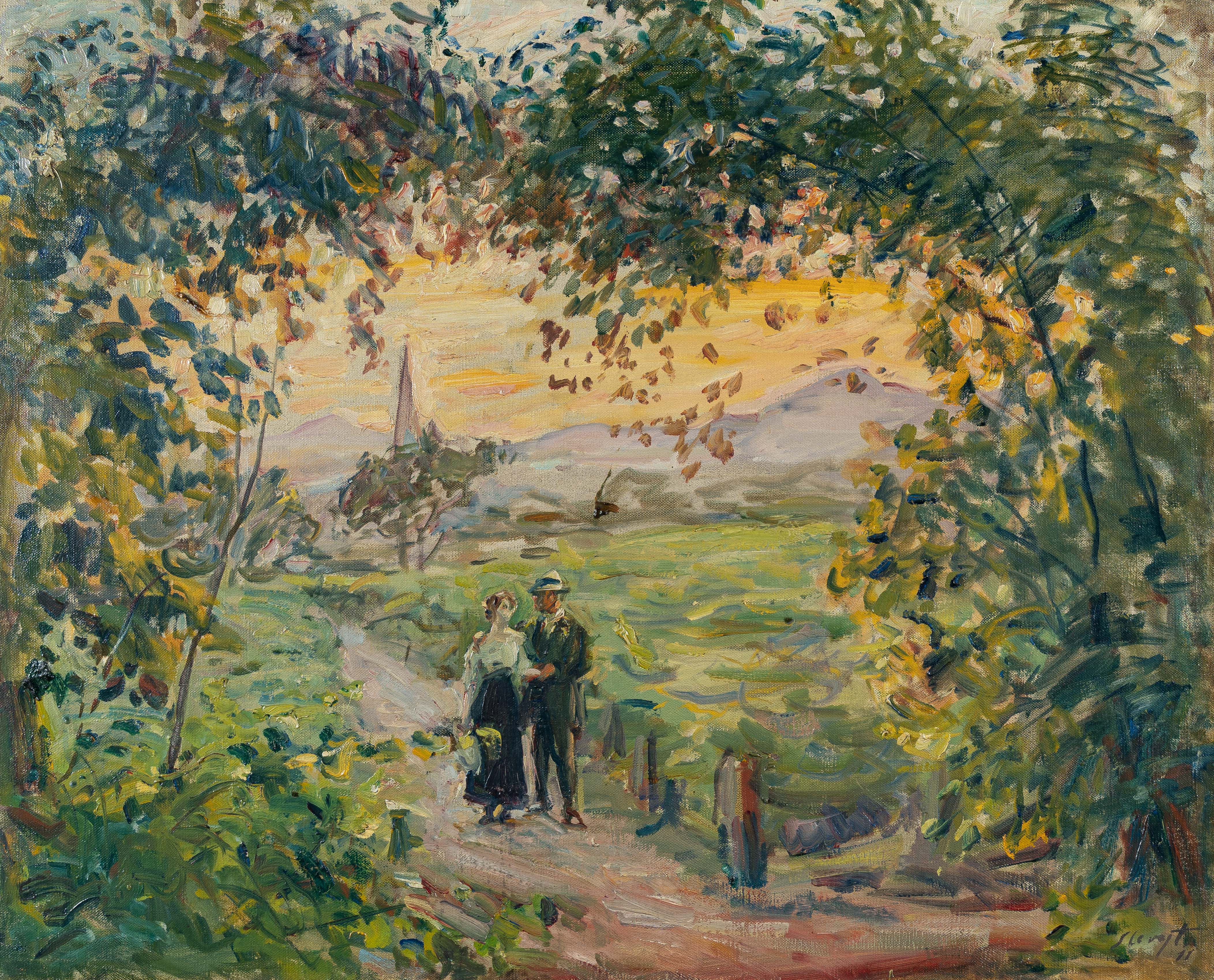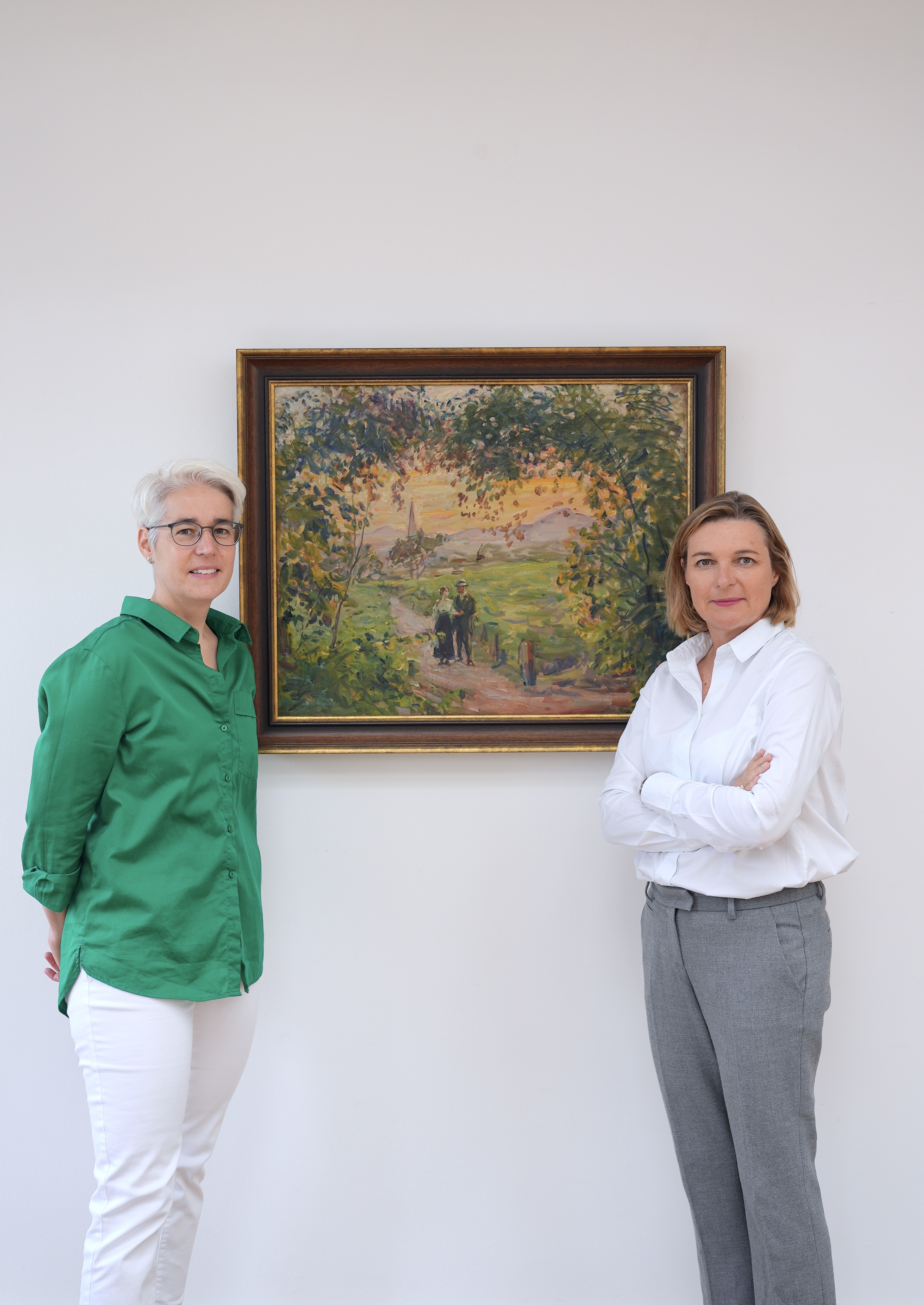Provenance Revealed: “Spaziergang” (The walk) by Max Slevogt
Under the title “Provenance Revealed”, we present the handling of provenance research in daily practice in an exciting series of contributions. In our second contribution, we introduce an exciting case from our past summer auction.
In spring 2023, the 1911 painting “Spaziergang” (The walk) by Max Slevogt (1868 Landshut – Neukastel/Pfalz 1932) was consigned to the anniversary auction at Karl & Faber. During the cataloguing of the work, a search notice for this very painting was found in the Lost Art database of the German Centre for the Loss of Cultural Property, Magdeburg. As a standard procedure, all works of art created before 1945 are checked against this database. In the following, we will refer to the painting as “Spaziergang”, even though it was given many different titles over the years (“Spaziergang”; “Sonnenuntergang”; “Landschaft”; “Landschaft mit Paar im Sonnenuntergang”; “Sonnenuntergang Godramstein”; “Spaziergang – Mailandschaft bei Godramstein”; “Pfälzer Landschaft mit figürlicher Staffage”).
The extensive provenance research that now followed led to an astonishing result and shows that not all works of art listed in the Lost Art database automatically have to become a restitution case. But let us start from the beginning:
Since 1917 at the latest, the “Spaziergang” has been in the possession of Hugo Nathan, a collector from Frankfurt. In that year, the magazine “Kunst und Künstler” devoted a comprehensive and richly illustrated review to Nathan’s private collection. At the time, the author referred to it as “among those which, through the chosen quality of their holdings, must particularly captivate the connoisseur and enthusiast and stimulate them again and again. And although the collection has only come into being in the last two decades (…) it is one of the best of its kind, and almost every work it contains means a valuable, pleasing acquaintance.” Hugo Nathan was primarily enthusiastic about French and German paintings of the Barbizon School, Impressionism and Post-Impressionism, as well as Realism, so that his extensive collection shines with numerous important artists’ names: Corot, Courbet, Daumier, Renoir, Monet, Pissarro, Toulouse-Lautrec, Van Gogh, Gauguin, Bonnard, Vlaminck, Maurice Denis, Jozef Israëls, Segantini, Hodler, Wilhelm Trübner, Hans Thoma, Max Liebermann, Hans von Marées, Fritz von Uhde, Lovis Corinth, Max Slevogt and other artists of the Kronberg painters’ colony. On his death in 1922, Hugo Nathan’s wife, Martha, inherited the art collection. Martha Nathan decided to emigrate from Frankfurt to Switzerland in 1938 after the National Socialists seized power, which resulted in the increase of repression and the threat of persecution. However, all her belongings were searched and confiscated, including her oil paintings, amongst them the Slevogt painting “Spaziergang”. In May 1938, the Nazis handed it over as “valuable cultural property” to the Städel Museum in Frankfurt for safekeeping, where it remained during the war.
In recent years, the Städel museum has been one of the pioneers of provenance research amongst German museums and has intensively investigated its own history during the National Socialist era. In 2011, the museum director at that time, Max Hollein, together with the art historian, Uwe Fleckner (founder of the “Degenerate Art” research centre at the Free University of Berlin in 2003) published the comprehensive publication “Museum im Widerspruch. Das Städel und der Nationalsozialismus”. It provides a 25-page “List of works of art restituted in the post-war period”, which came into the possession of the museum through confiscation and were returned to their rightful owners or to the central collection point in Wiesbaden after 1945. The return of the “Spaziergang” to Martha Nathan is also listed in this documentation (page 330).
Thanks to the support of Dr Iris Schmeisser, Head of Provenance Research and Historical Archive at the Städel Museum, we were able to view the archive files and extensive correspondence on this case in digitalised form. These prove that after long and tough negotiations, Martha Nathan finally succeeded in getting back three paintings, including the Slevogt. A receipt signed by Martha Nathan dated 1 May 1952 is available in the archives of the Städel Museum. The painting then returned to the German art market at the end of the 1950s: in 1959, the Frankfurt art dealer Schneider acquired it from Mr Robert Achard, who presumably sold it on behalf of the estate of Martha Nathan, who died in 1958. It was subsequently sold to the Albert Daberkow art dealer in Bad Homburg. Most recently it was part of a private collection in southern Germany.
With this detailed information and archival documents, Karl & Faber was able to obtain the deletion of the search entry in the Lost Art database and successfully sell the painting in the anniversary auction in June 2023 for €38,100 (incl. buyer’s premium).
The US law firm representing Nathan’s heirs then had a new entry placed in the database, with reference to a possible second version of the painting that had been confiscated in Paris in 1942. However, this is no longer directly related to our painting.
Christiane Beer



